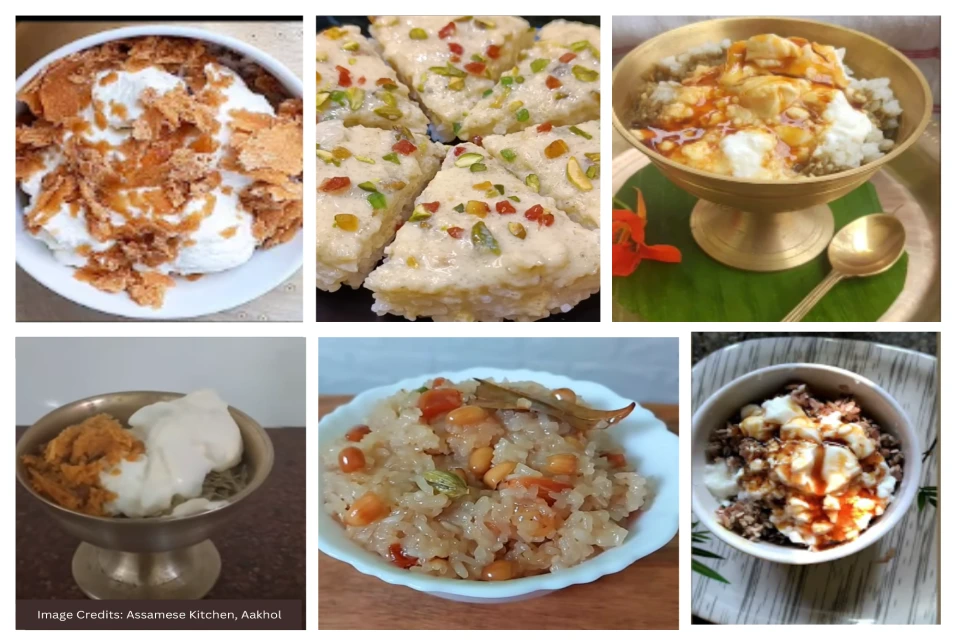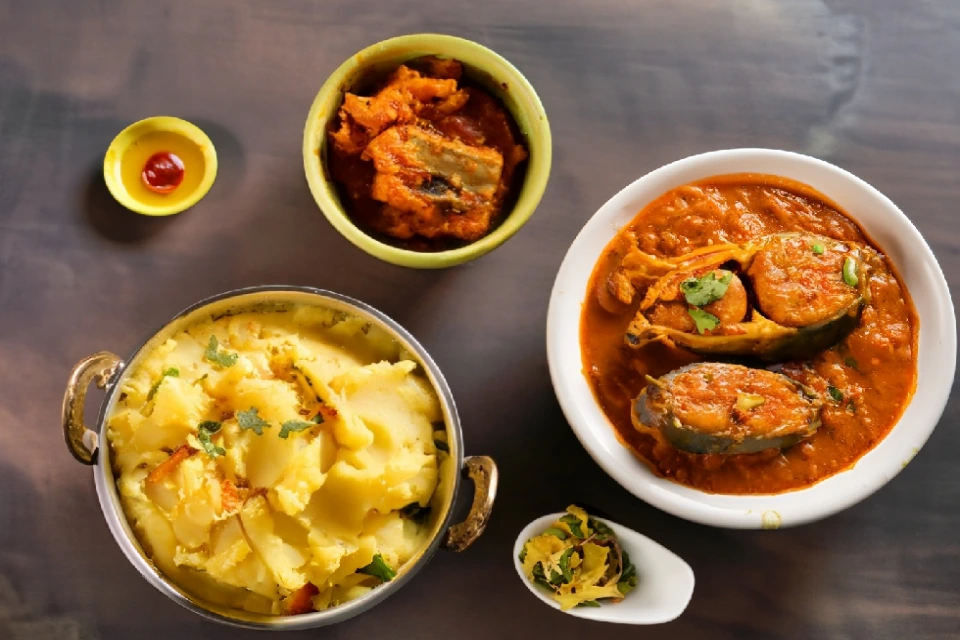Explore Jolpan, the century-old traditional, nutritious breakfast of Assam, its authentic ingredients,recipes, serving style, and health benefits.
Diversity Assam
Updated on :
Share this post
If you are a morning person, you must be familiar with a lot of breakfast options, but have you ever wondered what Assamese people traditionally used to consume in the morning?
The breakfast food people in Assam traditionally used to consume is collectively called Jolpan.
Jolpan is one of the oldest foods every Assamese has been consuming as their first meal to break the fast for ages. This traditional breakfast is also served during occasions like Bihu and weddings.
The way Assamese people are famous worldwide for their hospitality. Their food is also the essence of their pure hearts. The Assamese women put their soul into making the cuisine, and this traditional breakfast is a representative of their magical hands and skilled cooking ability.

This article will guide you through the origin of Jolpan, its ingredients, preparation, and the various benefits it has on our health.
Let’s explore more about Jolpan
What is Jolpan and how it was started?
In Assamese, the literal meaning of the word “Jolpan” is water(“Jol”) and pan( “Betel Leaf”). It is generally served with pithaas (“Sweet /salty regional rice snacks”), larus (spherical sweet balls), and laal saah (red tea).
Regarding the origin, there are many theories revolving around it. Some say, “It has been there since the times of the Ahom Dynasty, a medieval kingdom that settled in and around the Brahmaputra valley around the 13th century, as a lot of books written in Tai-Ahom language mention the existence of it.”
Moreover, the mention of curd (“Doi”), flattened rice (“Chira”), and pithas can also be found in “Burhi Aai’r Xadhu” (“Grandma Stories”) , a popular book containing a collection of stories or folklore by renowned Assamese author and poet Lakshminath Bezbarua.
Primary Ingredients of Jolpan
Primarily, it is prepared using the following authentic ingredients. It consists of Roasted or Ground Rice (“Xandoh”), Flattened Rice, Puffed Rice (“Muri”), Soaked Sticky Rice (“Kumol Saul”) or Cooked Sticky Rice (“Bora Saul”), Popped Rice (“Akhoi”) and Puffed Sticky Rice (“Hurum”).
They are consumed in addition with curd/yogurt or cream along with Jaggery (“Gur”) on top of it. Various types of pithas are also served with it.
Health benefits of Jolpan
Jolpan will benefit your health in various ways if you cook it the way that traditionally Assamese people used to. Apart from preventing your gut, this healthy breakfast will benefit you in the following ways:
- Curd or yogurt containing probiotics will enhance gut health, boost the immune system, and maintain a healthy balance of gut bacteria. Curd is also a source of protein, which assists in the building and repair of tissues in your body.
- All the different rices mentioned above also provide protein in small quantities. Generally, apart from puffed rice( which has a high glycemic index value), all the rice is recommended to use if you are health conscious, as each of them has a low glycemic index value.
How to prepare Jolpan ?
The procedure for preparing the authentic traditional Assamese breakfast is, in itself, a testimony to its healthy nature. Depending on the type of rice used, the steps to prepare it differ.
If you are having it using puffed rice, roasted or ground rice, soaked sticky rice, or cooked sticky rice, then take a handful of the same in a bowl and add curd/ yogurt/ cream and jaggery on top of it as per requirement.
But if you are having it with flattened rice, then soak the rice for 15 minutes in warm water. After that, squeeze the water out of the rice and put the rice in a bowl. Add curd/ yogurt/ cream, and jaggery on top of it as per requirement.
The serving style and hospitality
In an Assamese household, along with jolpan, other delicacies like pithaas, larus, laal saah, luci or puri made from refined flour, and potato curry are also served.
In a traditional household, following the above servings, your breakfast will end with tamul-paan (bettle leaf with areca nut), with a little amount of suun, or white lime paste, on the paan.
Various Jolpan and their primary recipes
- Bora Saul Jolpan: First, cook the Bora Saul (Bora rice or sticky rice) in a cooker for some time. After it is cooked, add curd or yogurt and jaggery on top of it, and your dish is ready. If you don’t want a sweet taste, you can have it with either non-veg sabji or veg-sabji.
- Kumol Saul Jolpan: Take some amount of Kumol Saul (instant rice) in a bowl, add hot water to it above the rice level, and leave it for 15 minutes. After it is properly soaked, put the rice in a steel strainer for 10 minutes. Then take the rice in a bowl, add curd or yogurt, put jaggery on top of it, and finally your Kumol Sau Jolpan is ready to be served.
- Xandoh Guri Jolpan: In a bowl, take some roasted or ground rice, put curd or yogurt, and jaggery on it. Awesome! Your Xandoh Guri Jolpan is ready to be tasted.
- Chira Jolpan: Put some handfuls of flattened rice in a bowl, add hot water to it above the rice level, and let it soak for 15 minutes. After 15 minutes, manually squeeze the rice to wring out water from it. Then put the rice in a bowl and add curd or yogurt and jaggery to it. Superb! Your dish is ready to be served.
- Sunga Saul Jolpan: Soak the rice for 24 hours, then after that put the rice along with the water in a bamboo, put it on heat for 40 minutes, and then have the sticky rice along with curd / yogurt / milk, and jaggery to get a sweet taste. You can also have it with non-veg or veg curry.
- Muri Jolpan: Take puffed rice in a bowl as per your desire, add curd/yogurt/ milk and put some jaggery over it. And your dish is ready to be eaten.
- Akhoi Jolpan: Take popped rice in a bowl, add curd/yogurt/ milk to it, and sprinkle some jaggery over it.
- Hurum Jolpan: Put some puffed sticky rice in a bowl as per your requirement, add curd/yogurt/ milk to it, and put some jaggery on it. You can have it with pithaas or any other delicacy.
Want to explore more ?
Till far you just explored types of Jolpan, their recipes, serving style and health benefits, but it can have bad effects on health and eating habit.
Since Diversity Assam is focused in reviving the culture by not letting the traditional methods vanish, so we discussed about traditional breakfasts of Assam only.
With modernization, people started focusing on the modification of everything. Instead of curd and jaggery, modern society has different types of it with cream, sugar, chocolates, etc. It is not only fatal for health, but eventually we will lose the traditional age-old methods.

Diversity Assam is the first of its kind content publisher from Assam, proudly publishing blogs, articles and stories to promote the natural, social, cultural, and financial diversity of Assam. Contact us at editor@diversityassam.com


